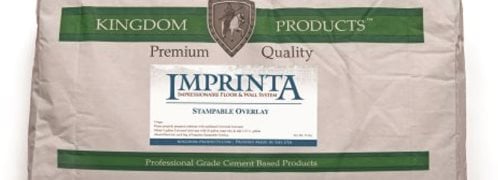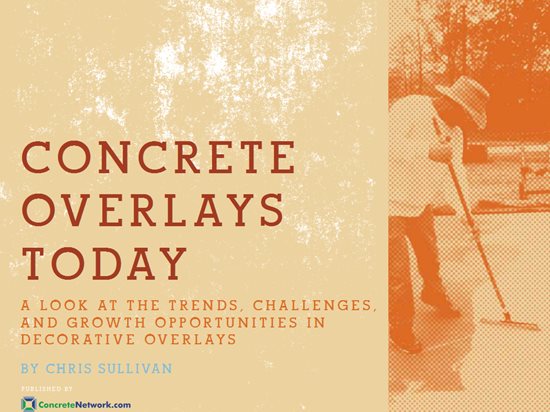- Concrete Overlays Home
- Get the Look - Interior Overlay Pictures
- When to Use a Polymer Overlay
- Comparison Chart of Overlay Systems: Which is best for your project?
- Five Factors to Consider when Choosing a Resurfacing System
- Concrete Overlay Reviews
- Types of Overlays
- Epoxy Coatings
- Microtoppings & Skim Coats
- Self-Leveling Overlays
- Spray-Down Toppings
- Polishable Overlays
- Stamped Concrete Overlays
- Preparing Concrete for Resurfacing
- Concrete Resurfacing
- Reducing Bond Failures Caused by Moisture-Vapor Transmission
- Don't Let Water Vapor Delaminate Your Overlay: How to seal concrete before an overlay
- How-To Tips for Installing Concrete Overlays
- Answers to Common Questions About Concrete Overlays: Advice from expert Chris Sullivan
- How to Add Color to Concrete Overlays
- How to Protect and Maintain Resurfaced Concrete
- Overlay Tools: Seven essential tools for concrete resurfacing
- Related Information
- Concrete Overlay Videos, with Bob Harris
- Decorative Concrete Overlays: A primer of the various overlay types and the decorative possibilities with each
- Vertical Concrete Overlays: Lightweight cement-based overlays mimic stone, brick, and other wall textures
Color and Pattern Trends in Decorative Overlays
Less is more when it comes to today’s overlay finishesThis is an excerpt from the new e-book “Concrete Overlays Today,” part of a series of reports from ConcreteNetwork.com on trends and insights about decorative concrete applications.
Free E-book:
Concrete Stamping Today
Discover seven rising trends in the overlay industry from ConcreteNetwork.com’s new e-book. You’ll get insights and advice from veteran overlay installers that will help you find success in today’s market.
Download Concrete Overlays Today (PDF)
The decorative overlay industry has come full circle in regard to design and color. In the early 1960s, overlays were mostly gray, with more of a utilitarian function. As the market grew and expanded, the use of complex colors and patterns became the trend. This movement reached its peak about the time the industry slowed down in 2008. We now see the market returning to clean and simple finishes. Gray is back as one of the most popular colors, as the contemporary industrial look has returned. The days of complex pattern and bright intense color have been replaced with soft, single-color finishes, muted earth tones and clean lines.
No matter if the work is residential or commercial, “less is more” when it comes to current overlay color and design trends, according to Chris Becker, managing director of the architectural concrete division of Stockness Construction, Hugo, Minn. “Seven to ten years ago it was all about how different and unique the floor can be. Today it is about clean, simple, and cost-effective.”
Even in the trendy design markets of southern California, a minimalist approach has taken hold. “Anything goes in our marketplace, but at the same time we see less bright colors and more industrial gray finishes being requested,” says Ryan Connors, owner of Modern Concrete Surfaces, Signal Hill, Calif. However, not all jobs have gone to industrial gray. Becker likes working color into his overlay projects, but in subtle ways. His crews will work multiple thin layers of light-colored microtopping on top of each other, very much like Venetian plaster. They then come back and apply diluted stains and dyes to accentuate the natural variations and marbling in the microtopping colors. The final look is colorful, while still looking soft and clean.
The trend toward lighter colors can also be seen on exterior projects. The demand for high Solar Reflectance Index (SRI) values have driven exterior pavements toward lighter colors so they can contribute toward LEED points on a project.
The design flexibility, durability and clean look of decorative overlays have really taken hold in hotels and chain stores. Connors has established good repeat business by working with corporate accounts that want reproducible flooring systems that fits their design requirements. “We sell a style and look to a company with lots of stores,” he says. One example is a regional coffee store chain that was looking to update the look of their stores. “They wanted a more modern look, but needed a floor that can handle the heavy foot traffic,” says Ryan. The system they settled on was a microtopping in a soft, clean color, with the company logo stenciled into the floor and a durable, chemical-resistant matte finish sealer. Connors’ crew is traveling all over California applying this finish to all the stores. “We are able to provide them with the same look at all of their locations.” Because of the simplicity and reproducibility of the microtopping system, Connors is able to plan each job ahead of time and save on labor.
While not the current trend, multicolored and patterned overlay work is still applied quite often. When multicolor overlays are installed, the method for separating colors varies depending on the system being used. “Shallow decorative sawcuts are still the go-to method for creating a pattern in a microtopping floor,” says Terry Grimble, director of technical services for Bomanite Company. “With thicker-section overlays, terrazzo strips or other metal dividers have become the popular method for creating a pattern of color separation.”
Stencils are a popular method for creating patterns in decorative overlays, especially corporate logos. The logos are often used by restaurants and retail stores and are located on the floor at the front entrance and in other high-traffic areas. The use of stencils and patterns to create more artistic finishes on knock-down exterior microtoppings has also grown significantly over the past decade. The beauty of stencils used in conjunction with overlays is the number of variations that can be achieved. One of the most popular is to trowel apply a thin coat of microtopping over a stencil to provide an almost seamless two-dimensional graphic once the stencil is removed.
Related information:
Where to Get Color Inspiration
Concrete Overlays
Return to Concrete Overlays Today
 Rapid Set Skim Coat
Repairs, levels, and smooths concrete for applications.
Rapid Set Skim Coat
Repairs, levels, and smooths concrete for applications.
 Thin Micro-Topping
Produces durable surface to color or stain
Thin Micro-Topping
Produces durable surface to color or stain
 Self Leveling Overlay
Find the overlay to meet your project's needs
Self Leveling Overlay
Find the overlay to meet your project's needs
 T1000 Stampable Overlay
For use with resurfacing concrete floors and hardscapes.
T1000 Stampable Overlay
For use with resurfacing concrete floors and hardscapes.
 Kemiko® Buildable Overlay
Decorative interior or exterior resurfacing
Kemiko® Buildable Overlay
Decorative interior or exterior resurfacing
 Flooring & Coating System
Epoxy Flooring System designed for concrete
Flooring & Coating System
Epoxy Flooring System designed for concrete
 Stamped Concrete Overlay
Warm weather and cold weather formulas
Stamped Concrete Overlay
Warm weather and cold weather formulas
 Imprinta Stampable Overlay
2-component system
Imprinta Stampable Overlay
2-component system





